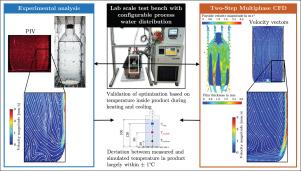袋瓶热水淋浴灭菌过程配水优化:数值与实验研究
IF 5.4
3区 工程技术
Q2 ENERGY & FUELS
引用次数: 0
摘要
热水淋浴消毒是至关重要的,以确保病人安全的药品生产液体在瓶或袋形容器。用于传热的层叠式淋浴的相同原理也用于食品工业的巴氏杀菌。然而,对于优化能源使用和加工时间的验证仿真模型的研究有限。本研究在实验室规模的试验台上对淋浴加热和冷却的两步多相计算流体动力学(CFD)模拟模型进行了实验验证。通过流动和膜态分析、产品温度测量和颗粒图像速度测量(PIV)来评估玻璃瓶和聚丙烯袋的加热和冷却。试验了不同的工艺水流量和分配盘设计。最慢的加热和冷却区域的瓶子被确定在2%和98%的瓶子的填充高度分别。测量值与模拟值之间的温度偏差大多在测量不确定度范围内。PIV的新应用进一步验证了仿真模型预测的内部流动特性。经过实验和模拟测试,优化的配水盘设计减小了孔距,显著减少了玻璃瓶在较低体积流速下的加热和冷却时间。本研究的实验和数值结果表明,优化的水塔可以缩短灭菌或巴氏灭菌周期,即使在降低体积流量的同时也降低了能耗。本文章由计算机程序翻译,如有差异,请以英文原文为准。

Optimization of the process water distribution for hot water shower sterilization of bags and bottles: A numerical and experimental study
Hot water shower sterilization is crucial for ensuring patient safety in the pharmaceutical production of liquids in bottle- or bag-shaped containers. The same principle of cascading water showers for heat transfer is also used in the food industry for pasteurization. However, there is limited research on validated simulation models to optimize energy use and process time. This study experimentally validates a numerically efficient two-step multiphase Computational Fluid Dynamics (CFD) simulation model for shower heating and cooling on a lab-scale test bench. Flow and film regime analysis, product temperature measurement, and particle image velocimetry (PIV) are conducted to assess the heating and cooling of glass bottles and polypropylene bags. Varied process water flow rates and distribution tray designs were tested. The slowest heating and cooling zones of the bottle were identified at 2% and 98% of the bottle’s filling height, respectively. The temperature deviations between measurements and simulations were mostly within the margin of measurement uncertainty. The novel application of PIV further validated the internal flow characteristics predicted by the simulation model. An optimized water distribution tray design with a reduced hole pitch, tested experimentally and through simulation, significantly reduced the heating and cooling times of the glass bottle at lower volume flow rates. The results of this study, both experimental and numerical, demonstrate that optimized water trays can shorten sterilization or pasteurization cycles even at reduced volume flow rates while also reducing energy consumption.
求助全文
通过发布文献求助,成功后即可免费获取论文全文。
去求助
来源期刊

Thermal Science and Engineering Progress
Chemical Engineering-Fluid Flow and Transfer Processes
CiteScore
7.20
自引率
10.40%
发文量
327
审稿时长
41 days
期刊介绍:
Thermal Science and Engineering Progress (TSEP) publishes original, high-quality research articles that span activities ranging from fundamental scientific research and discussion of the more controversial thermodynamic theories, to developments in thermal engineering that are in many instances examples of the way scientists and engineers are addressing the challenges facing a growing population – smart cities and global warming – maximising thermodynamic efficiencies and minimising all heat losses. It is intended that these will be of current relevance and interest to industry, academia and other practitioners. It is evident that many specialised journals in thermal and, to some extent, in fluid disciplines tend to focus on topics that can be classified as fundamental in nature, or are ‘applied’ and near-market. Thermal Science and Engineering Progress will bridge the gap between these two areas, allowing authors to make an easy choice, should they or a journal editor feel that their papers are ‘out of scope’ when considering other journals. The range of topics covered by Thermal Science and Engineering Progress addresses the rapid rate of development being made in thermal transfer processes as they affect traditional fields, and important growth in the topical research areas of aerospace, thermal biological and medical systems, electronics and nano-technologies, renewable energy systems, food production (including agriculture), and the need to minimise man-made thermal impacts on climate change. Review articles on appropriate topics for TSEP are encouraged, although until TSEP is fully established, these will be limited in number. Before submitting such articles, please contact one of the Editors, or a member of the Editorial Advisory Board with an outline of your proposal and your expertise in the area of your review.
 求助内容:
求助内容: 应助结果提醒方式:
应助结果提醒方式:


